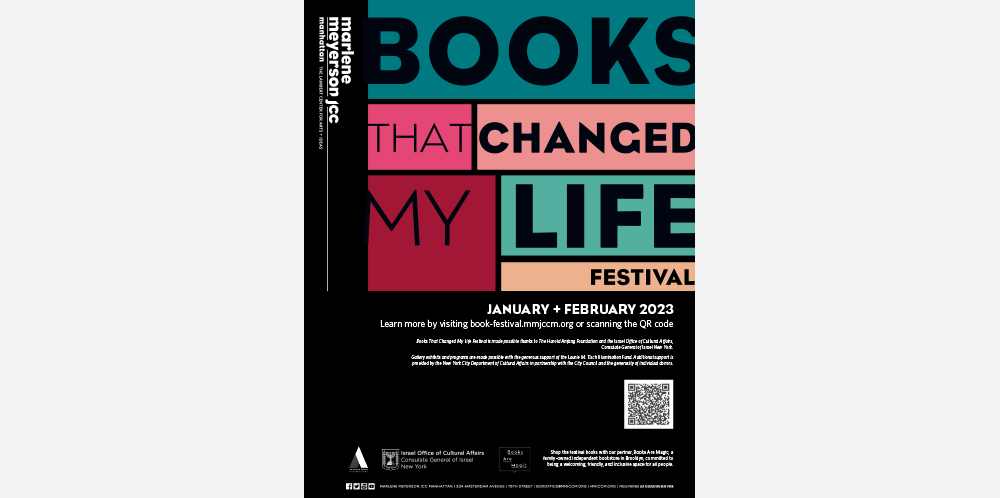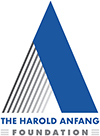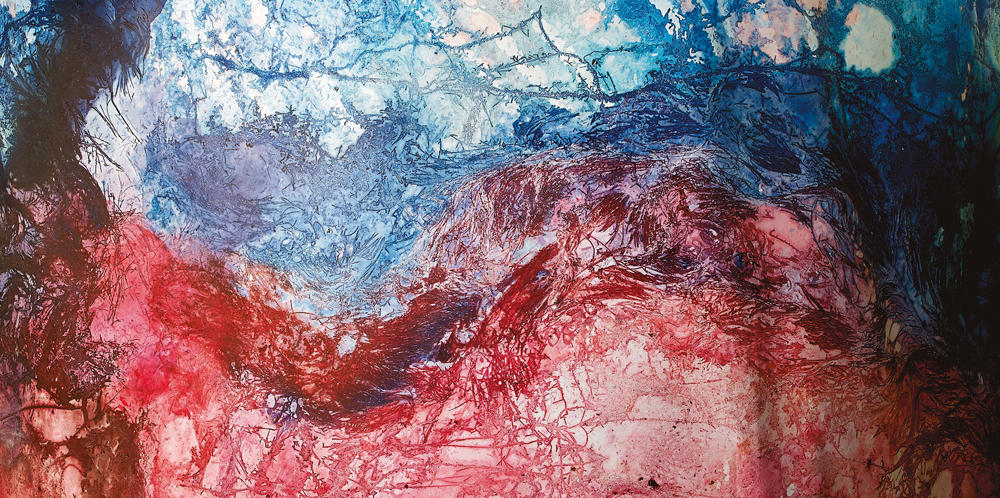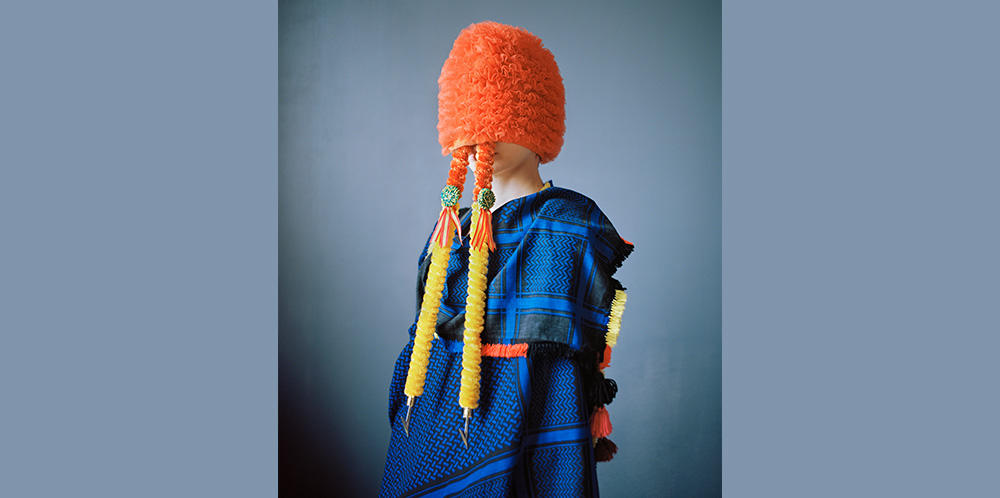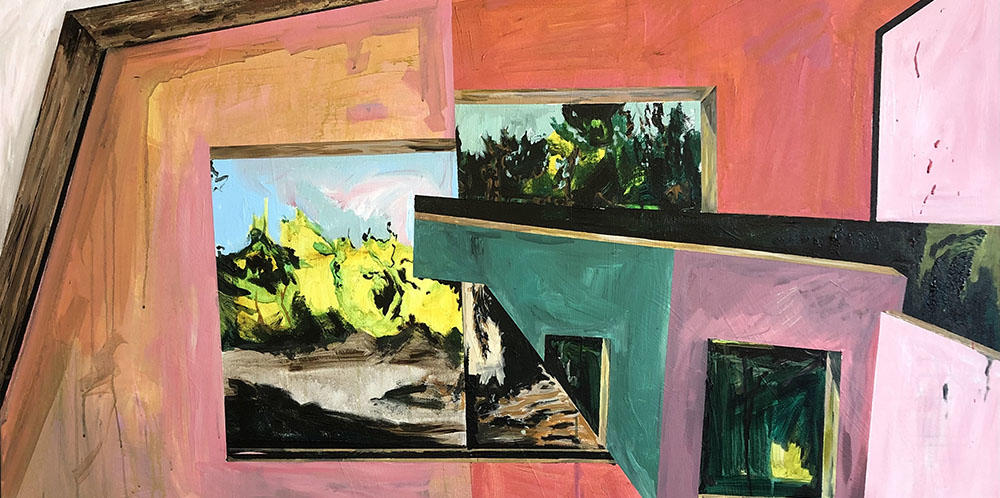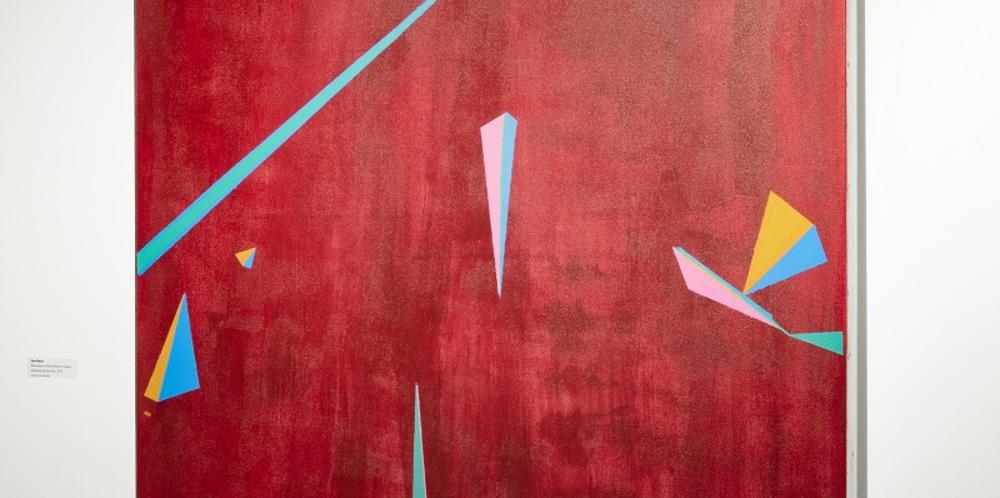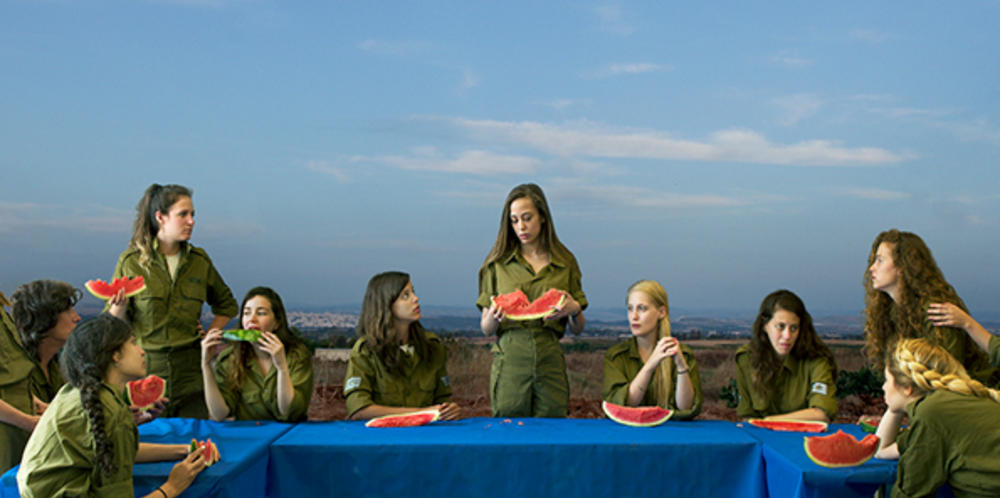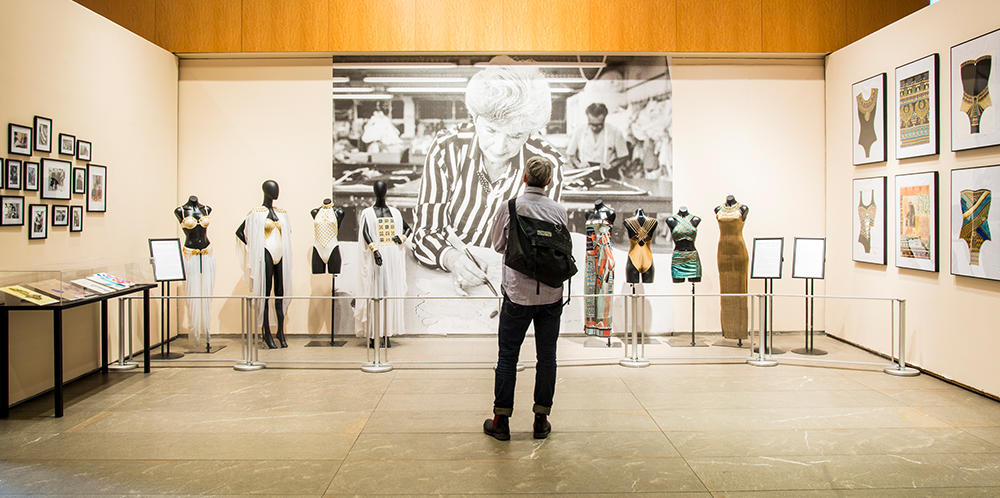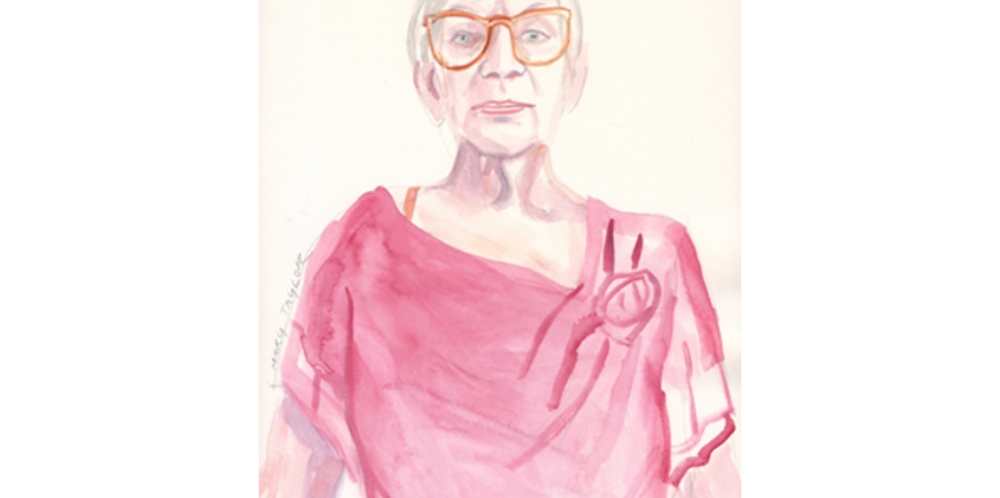Past Exhibits
Feathers, Gold + Concrete | Eliahou Eric Bokobza
Guest Project: Maps, Amulets + Wildflowers | Esther Cohen
Curated by Dr. Smadar Sheffi
The exhibit runs through May 31. Free and open to the public.
The JCC presents the exhibition Cities and Valleys: Spring at The Laurie M. Tisch Gallery, which is free and open to the public. Opening on Mar 7, it features Eliahou Eric Bokobza’s Feathers, Gold + Concrete and the guest project Maps, Amulets + Wildflowers by Esther Cohen.
The work of Eliahou Eric Bokobza examines Israeli cultural identity through brightly colored paintings, sculptures, and video animations, all through the lens of his North African Jewish roots. Esther Cohen’s work, on the other hand, traces a cultural journey through her Jewish Yemenite heritage, focusing on silversmithing, subverting the language of traditionally masculine craftsmanship in the process.
This exhibition explores Israel from two different perspectives, focusing on issues such as racism and patriarchal structures that are still topical today through the lens of historical craftsmanship. In tandem, Bokobza and Cohen's divergent approaches converge to offer a nuanced and multifaceted exploration of Israel, shedding light on the intricate layers of cultural identity and history within the nation's diverse tapestry.
Gallery exhibits and programs are made possible with the generous support of the Laurie M. Tisch Illumination Fund. Additional support is provided by the New York City Department of Cultural Affairs in partnership with the City Council and the generosity of individual donors.
Jan 4–Feb 27, 2024
The second annual Books That Changed My Life Festival returned in 2024 to celebrate the transformative power of books. This two-month celebration of literature and culture showcases events inspired by beloved literary works, including a pop-up library, author conversations, workshops, storytime, a gallery exhibit, musical performances, theater, film events, and more.
Hosted by the JCC's Lambert Center for Arts + Ideas, this festival was a testament to the power of storytelling and the enduring impact of words.
Featuring two exhibits from Contemporary Art Center Ramle (CACR), curated by Dr. Smadar Sheffi. Opening Sep 7. The exhibit runs through Nov 2. Free and open to the public.
Unheimliche, Longing, and the Floor Rag
Artist: Nahed Abo Alhega Hamza
Curator: Dr. Smadar Sheffi
Artist Nahed Abo Alhega Hamza draws on domestic textiles (floor rags, curtains, sheets) associated with cleanliness and the intimacy of a physically and metaphorically cushioned space. A friendly home, the object of longing, embodying family memories, may become an arena for violence and threat, evoking what Freud termed unheimliche, the "uncanny."
Abo Alhega Hamza's works present an encounter between home as a safe place and a site of fear. The body of work exhibited evolved after the artist's mother passed away in 2019, sparking a re-reading of "home" and its components. Her intricate drawings signify our complicated relationships with objects and their symbolic meanings, corresponding with art and ideas from Dada to Surrealism to science fiction. Strong emotions, including pain and anxiety, flow into the large black and blue ink portrait, which is cut out and embroidered on red fabric. Comprising drawings of hands, architectural details, intertwined muscles, plants, bones, and flowing water, it has art historical associations to Arcimboldo and Georg Grosz, among others.
Works on handkerchiefs from her parents' wedding preserve the folds as a grid of memories, hopes, innocence, and promise, embodying movement, vulnerability, and vitality, with a streak of the uncanny emanating from her oeuvre.
Rifts, Joints, and Rifts
Artists: Anna Hayat + Slava Pirsky
Curator: Dr. Smadar Sheffi
Anna Hayat and Slava Pirsky's photographs are exquisite. Most are printed on fabric, hand-sewn, and embroidered. This is the first time that the duo is exhibiting sewn images that simultaneously join and break apart. They have an almost corporeal quality, the stitches seeming to throb with pain like a wounded body.
Time itself becomes matter, an additional element in the photographs which comprise past and present, its density evident in the works with flowers. Hayat and Pirsky distill clichéd images and objects, then reilluminate them in a continuous dialogue between photography and painting.
The discourse on time is a central motif of their works. The photographs are shot on a large format view camera using outdated Polaroid film, whose chemicals leave random stains on the image. Solarization creates further uncontrolled reactions; chance becomes part of their aesthetic. Hayat and Pirsky integrate these chance reactions with controlled, precise photography in the tradition of early 20th century American photography, which, when combined with the unexpected, is intriguing.
Sewing the photographs, a new process for Hayat and Pirsky, began after their encounter with kintsugi, the Japanese art of “golden repair” (of broken pottery) without concealing flaws. The works were made while the artists were closely following developments in the war in Ukraine, fearful for the lives of friends and relatives. The many rifts in the works demonstrate a sense of urgency and injury.
Banner Art Credit:
Burdocks | Anna Hayat + Slava Pirsky
Hold On Together | Nahed Abo Alhega Hamza

Curated by Sharon Balaban | Mar 9–Apr 7 | Free + open to the public
About Veni, Vidi, Video
Artists: Sharon Balaban | Hilla Ben Ari | Dara Birnbaum | Shirley Clarke | Keren Cytter | Maya Deren | Hadassa Goldvicht | Mierle Laderman Ukeles | Hila Lulu Lin Farah Kufer Birim | Vivian Ostrovsky | Alix Pearlstein | Nira Pereg | Martha Rosler | Mika Rottenberg | Shelly Silver | Anita Thacher | Rona Yefman | Nevet Yitzhak
Taking its title from the declaration of masculine militancy and conquest attributed to Julius Caesar—Veni, Vidi, Vici (I Came, I Saw, I Conquered)—this exhibit highlights the role of Jewish female artists in shaping video art across many decades. It includes works from trailblazing American and Israeli artists and experimental filmmakers of the 1940s and 1950s and contemporary artists of the 1970s, through today’s works, which utilize new technologies and techniques.
In 1967, Sony introduced the Portapak, an easy-to-use video camera that required no crew, beginning a period of tremendous experimentation for artists. In the United States, and especially in New York City, women dominated the field of video art from early on and were vanguards of the second wave of feminism. In Israel, the 1990s were a turning point in the dominance of female video artists, and signified a larger “opening up” of Israeli art into the international art world.
Videos by 18 artists from these two counties explore the themes of human rights, gender, and social dynamics. Female artists have long used video technology to explore what it means to be female in a patriarchal society. The camera allows them to subvert social conventions and deconstruct cultural apparatuses and narratives, manipulating viewers’ expectations of what to expect from “moving images.”
Exploring work from a range of decades, Veni, Vidi, Video showcases the development of technology and its infiltration into the art and the everyday fabric of our society. These timeless videos remain relevant and continue to make their audience think and feel.
Featured Works
- Maya Deren: A Study in Choreography for Camera (1945)
- Shirley Clarke: Bridges-Go-Round (1958)
- Martha Rosler: Semiotics of the Kitchen (1975)
- Mierle Laderman Ukeles: Waste Flow (1977–79)
- Dara Birnbaum: Technology/Transformation: Wonder Woman (1978–79)
- Anita Thacher: Loose Corner (1986)
- Hila Lulu Lin Farah Kufer Birim: No More Tears (1994)
- Nira Pereg: Sabbath (2008)
- Vivian Ostrovsky: The Title Was Shot (2009)
- Sharon Balaban: Triumph (2009)
- Hilla Ben Ari: Seeding (2012)
- Hadassa Goldvicht: Kiss (2012)
- Nevet Yitzhak: Star Quality (2013)
- Rona Yefman: I'm So Glad (2008)
- Mika Rottenberg: Sneeze (2012)
- Alix Pearlstein: Monogram (2014)
- Shelly Silver: Turn 16 (2018)
- Keren Cytter: Terrorist of Love (2016)
- Sharon Balaban: Spider Blood (Black Ruby #807) (2022)
Gallery exhibits and programs are made possible with the generous support of the Laurie M. Tisch Illumination Fund. Additional support is provided by the New York City Department of Cultural Affairs in partnership with the City Council and the generosity of individual donors.
Books That Changed My Life Pop-Up Library
Jan 5–Feb 28, 2023
Books That Changed My Life is a new initiative, hosted by the JCC’s Lambert Center for Arts + Ideas, that celebrates the transformational role books play in our lives. Cozy up with a book from the pop-up library in The Laurie M. Tisch Gallery. We hope to bring a bit of joy to each of you as you peruse the shelves, scan the beautiful book covers, and chat with one another about your favorite titles.
Learn more about the Books That Changed My Life Festival.
Pop-up Library design: Studio Special Edition (se-design.co.il)
Books That Changed My Life Festival is made possible thanks to The Harold Anfang Foundation, the Israel Office of Cultural Affairs, Consulate General of Israel New York, and PJ Library.
Gallery exhibits and programs are made possible with the generous support of the Laurie M. Tisch Illumination Fund. Additional support is provided by the New York City Department of Cultural Affairs in partnership with the City Council and the generosity of individual donors.
Sep 8–Dec 15, 2022
Artists: Adam Yekutieli - Know Hope | Arik Weiss | Ashger Zamana | Avihai Mizrahi | Danielle Weinberg | David Tartakover | Dede Bandaid & Nitzan Mintz | Eli Khromov | Faina Feigin | Holyland Civilians - Anat Meshulam & Dor Chen | Jennifer Abessira | Kobi Franco | Lahav Halevy | Liron Lavi Turkenich | Matan Iontef | Naama Nechushtai | Neil Cohen | Noam Benatar | Oded Ben Yehuda | Omri Goldzak | Rotem Cohen-Soaye | Shavit Yaacov | Yossi Lemel | Zvi Narkis
Curators: Michal Shapira and Tom Kohen
Bless is a collection of graphic works by designers and artists from The Shenkar Research Center for Israeli Design, part of the Shenkar Academy, based in Ramat Gan, Israel, in collaboration with 3X3 Active Gallery. The research center, founded in 2006, maintains the most extensive digital collection in Israel of graphics and design by local artists who worked between 1850 and 2022. Bless is part inspiration, part call-to-action, emphatically reminding us that kindness, inclusion, peace, and unity are not simply aspirations but daily practices and individual actions.
3X3 Active Gallery is a dynamic format of curatorial activism, focusing on public spaces offline and online. Founded in 2020 by Michal Shapira and Lihi Gerstner.
Gallery exhibits and programs are made possible with the generous support of the Laurie M. Tisch Illumination Fund. Additional support is provided by the New York City Department of Cultural Affairs in partnership with the City Council and the generosity of individual donors.
Bless is sponsored by the Israel Office of Cultural Affairs, Consulate General of Israel New York.
Jun 14–Aug 28, 2022
Rotem Reshef
Offering a haven from the bustling city, Rotem Reshef’s painterly environment is created by two islands of color and texture. While suggesting a site of refuge, the site-specific installation presents a dual perspective of an inner world mirroring an exterior landscape, arresting in time the cycle of seasons. Reshef’s practice suggests that painting can shift modes, expand and modify our perception, like a story unfolding. Reshef’s work alludes to a long history of drifting and wandering—of her own, her family’s, and all of us who navigate a world of shifting restrictions—the closing and opening of borders and global migration. Movement through the space may allude to the crossing of the Red Sea, as the dry land offered a fantastical path of rescue and safety, a sudden and unexpected change of events that transformed a catastrophe into a trail for redemption.
Strolling urban environments like Walter Benjamin’s flâneur, Reshef picks up traces of abandoned history and signs of lives that existed and vanished: vegetation waste, twigs and scraps of wood, remains of a landscape, either planned or wild, are gathered once again, into the immortalizing world of art-making. By bringing these anonymous materials into the studio, Reshef offers renewal and healing, creating for viewers an opportunity to experience a revived beauty.
This exhibition continues Reshef’s installation from 2020, A Heartfelt Event, that reacted in real time to the influence of the COVID-19 pandemic and the political turmoil of that year on Israeli society and the artist’s own private life. Yet this time, Reshef reflects on the age “after” the crisis, its anxiety, and unknown long-term consequences.
Mar 17–Jun 5, 2022
Group exhibition by artists Guy Aon, Elinor Carucci, Omri Goren, Marie Hudelot, Iddo Markus, Michal Pollack, Gideon Rubin, Julie Weitz | Curated by Udi Urman
Unmasked explores the ancient, paradoxical relationship between artists and masks. The eight artists featured in the exhibit approach the concept of masking in ways unique to their cultures and identities. The historical context of masks will also be explored. Masks have been used throughout human history, intertwining traditions and collective identities, including during the Middle Ages, and when Jewish communities began celebrating Purim by wearing masks. In more abstract ways, Jewish people have often worn “masks” and disguised their identities, by changing their last names or physical appearances to avoid life-threatening antisemitism.
The use of masks in contemporary society will also be explored: masks have evolved from physical objects into digital filters flooding social media platforms. Throughout the COVID-19 pandemic, masks have become a major part of everyday life, saving lives and helping keep communities safe. They have also become a political symbol, bringing to the surface deep social tensions.
Group exhibition by Dana Levy, Gal Cohen, Lee Tal, Michal Geva, Naomi Safran-Hon, Noa Charuvi, Zac Hacmon
The Laurie M. Tisch Gallery
On view December 2, 2021 – February 28, 2022
Floating Walls presents a multidisciplinary survey of works made by seven Israeli artists based in New York. The exhibition incorporates site-specific installation, video, painting, and sculpture. By using a variety of materials across media, the artists explore and reimagine the walls that surround them as both material and metaphor. As Israelis living in New York, the artists in this exhibition are familiar with migration and reconstituting one’s definition of and relationship to home. Additionally, the works on view allow us to reflect on how the COVID-19 pandemic impacted our sense of place, as we entered periods of lockdown in our domestic environment, and renegotiated our position regarding public and shared spaces.
Curated by Aya Goshen
On View February 25 - April 13, 2020
Ritual binds people across time and space, building norms that cultivate personal and collective meaning and structure. Akin to this, rituals captured through experiences of disability and illness create temporalities of time and space that are flexible and fluctuating, not easily defined by static structures designed without disabled and sick people in mind. The artists in this exhibition reconfigure what constitutes and marks the mundaneness of the everyday through ritual, tapping into embodiments of living with illness and disability to create a never-ending flow of curiosity and contemplation. Through abstraction, the artists claim space, mark time, and present expansive ways of understanding illness and disability. These configurations of disability maintain bodily knowledge as vital to a rumination on the corporeal and our existence in an interdependent world. In the artists’ own formulations of sick and disabled aesthetics, time, and space, this exhibition showcases different ways illness and disability have connective and ritual potential.
Listening to our bodies and their needs in all their sick and disabled glory opens opportunity for honoring and caring for the body/mind and for others, insisting on bodily knowledge and care as invaluable in the continued effort toward building understanding and an equitable society. The artists articulate the complexity of exhaustively living with chronic pain, navigating care systems, and reckoning with relationships to self and to others through demarcations of patterning, flickering, shading, scattering, jolting, and reflecting. The range of works presented are linked to the enduring legacy of exercising rituals to hold meaning and structure for living in a complex and chaotic world.
Curated by Ezra Benus.
Rituals is presented in partnership with ReelAbilities: New York Film Festival.
On View September 3–December 15, 2019
Angelika Sher was born in 1969 in Vilnius, Lithuania. She immigrated to Israel, where she graduated from the Bezalel Academy of Art and Design in Jerusalem and established erself as a critically acclaimed professional photographer through a series of exhibitions in Israel and abroad. The Laurie M. Tisch Gallery is honored to present a series of her work that explores the mental and emotional changes in her daughter and her daughter’s friends who enlisted in the IDF and the way they encounter cultures, religions, and histories. The series also reflects the change that took place in the artist, as she revisits issues that she explored when she was the age her daughter is now and as both reflect on their role as women and human beings today.
Angelika Sher: Selected Work is presented in partnership with Zemack Gallery, Tel Aviv.
The Laurie M. Tisch Gallery, located in the lobby of the Marlene Meyerson JCC Manhattan, is a versatile exhibition space dedicated to the promotion of multidisciplinary exhibits that offer new perspectives on the rich history and values of the community.
The gallery hosts five to six exhibitions every year, each one running for approximately two to three months. Exhibits range from solo artist shows to historical multimedia exhibits and touring shows from museums and galleries around the world. A public space, the Gallery welcomes thousands of people each week, young and old, Jewish and not Jewish. All visitors can engage with the images and ideas expressed in this unique public space.
Hours
Mon–Thu, 5:30 am–10:30 pm
Fri, 5:30 am–9:30 pm
Sat and Sun, 7 am–9:30 pm
January-April 2019
"Everything good about America begins with a protest." So declares a handmade poster photographed at the Women's March on Washington, DC, on January 21, 2017. Indeed, America itself was born of protest when, in 1773, the Boston Tea Party galvanized colonial resistance to the British policy of "taxation without representation," leading to the American Revolution and the Declaration of Independence. Over the more than two centuries since, protest has defined and reshaped the landscape of American rights and justice. In partnership with Magnum Photos, this exhibition features photographs of protest from the 1940s to the present day. From street marches and consumer boycotts to civil disobedience and hashtag activism, this exhibit emphasizes protest as a powerful form of civic engagement.
Magnum Photos represents some of the world's most renowned photographers, who share a vision to chronicle world events, people, places, and culture with a powerful narrative that defies convention, shatters the status quo, redefines history, and transforms lives.
Cosponsored with The Joseph Stern Center for Social Responsibility.
Sep 4–Dec 16, 2018
The Laurie M. Tisch Gallery is honored to present Brenda Zlamany: 100/100, an exhibit of 100 watercolor portraits of residents of the Hebrew Home at Riverdale.
The exhibit, which features 100 portraits of residents of the Hebrew Home at Riverdale, honors overlooked members of society. Zlamany involved her subjects in an artistic process that upholds their value and displays the beauty and wisdom that come with age.
As she painted, Zlamany asked herself questions about the end of life that are conveyed in the energy of the portraits. “In the face of loss—loss of loved ones, mobility, taste, hearing, sight—can there still be joy? What is the role of memory? How do past experiences fuel happiness in the present?”
100/100 is the most recent chapter in Zlamany’s ongoing project, “The Itinerant Portraitist,” in which she explores the constructive effects of portraiture in communities around the globe. Previous chapters involved Aboriginal people in Taiwan, girls in an orphanage in the United Arab Emirates, artists in Brooklyn, and taxicab drivers in Cuba.
Zlamany is a painter who lives in Brooklyn. Since 1982, her work has appeared in many solo and group exhibitions in the United States, Europe, Asia, and the Middle East. She has received a Fulbright Fellowship, a Pollock-Krasner Foundation grant, a New York Foundation for the Arts Artists’ Fellowship in painting, and a Jerome Foundation Fellowship. Yale University recently commissioned two large-scale group portraits by her for permanent public display on campus.
Brenda Zlamany: 100/100 is part of Reimagine End of Life (letsreimagine.org). The exhibit originated during an artist’s residency at the Hebrew Home at Riverdale by RiverSpring Health in 2017 and was first presented at Derfner Judaica Museum + The Art Collection from Sep 10, 2017, to Jan 7, 2018.
For more information, please visit letsreimagine.org.
September 23 - October 8, 2018
The Marlene Meyerson JCC Manhattan is honored to present renowned Israeli artist Avner Sher’s Jerusalem 950m2 (Quarter acre) Alternate Topographies.
For this project, Sher looked at the intercultural encounters taking place in Jerusalem’s Old City as a crossroads between geography and history, art and reality, truth and fantasy. The area of reference, less than a quarter of an acre, contains sites holy to the three major monotheistic religions, causing century-long battles. The city bows under conflicting ideologies and beliefs, attracting passions and fears, becoming a focus of faith and hope.
For Sher, as for many generations of artists, Jerusalem is simultaneously a concrete and symbolic locale, in which the tension between the eternal and the transitory dominate. Avner Sher’s installation is not about Jerusalem as it is today, but as it could have been, presenting it as a concept and not a specific place. The sukkah and the artworks inside of it are made mostly of cork, the external bark of the cork tree, peeled off the trunk once every nine years. Cork’s renewal process is integral to the spirit of Sher’s proposed concept of Jerusalem.
About the Artist: Avner Sher is one of Israel’s most successful commercial architects. He earned his degrees from the Technion, Israel Institute of Technology and Haifa University. An encounter with graffiti and vandalism encouraged Sher to embrace the raw and violent nature of the vandalistic act. His work is the result of a physically demanding process of injuring, scratching, etching, engraving, and scorching large cork and wood panels. Sher’s work has been exhibited around the world.
This project was introduced as part of the Jerusalem Biennale 2017. A large-scale sukkah, designed by Avner Sher, was built on the western porch of the Tower of David Museum, just below the iconic Minaret, and functioned for seven weeks as Avner Sher's pavilion.
Installation courtesy of E3 {a small gallery}.
Apr 18–Jul 31, 2018
Highlighting the four central collections at the impressive National Library of Israel, this exhibit will focus on the spiritual realm—with sacred books, sacred places and mysticism as well as the ethnographic and secular realm—with Israeli culture and Hebrew/Jewish language. An array of facsimiles of illustrated manuscripts, ancient maps, posters, and photographs, this exhibit will introduce our community to the amazing treasures of the Library.
[H2] REDEFINING: 10 Fountain House Gallery Artists Living and Working with Mental Illness
Mar 8–Apr 5, 2018
Redefining showcases an array of works by Fountain House Gallery artists. In celebration of the 10-year anniversary of the ReelAbilities Film Festival, which spotlights the diversity of abilities in our world, pieces by 10 Gallery artists working in a variety of mediums were selected for inclusion in this exhibit. Fountain House Gallery and Studio is a nonprofit art program that provides an environment in which artists living with mental illness can express their creative visions, exhibit their work, and challenge the stigma that often surrounds mental illness.
Jan 3–Mar 1, 2018
The Laurie M. Tisch Gallery is thrilled to present the work of Oded Balilty for his first New York exhibit. Balilty is the first and only Israeli photographer to win the Pulitzer Prize, which he was awarded for work he did for The Associated Press in 2007. His photojournalism has taken him all over the world, and his fine art photography has been exhibited widely in Israel and Europe. This exhibition features two of Balilty's ongoing series: Glass Mountains and Sabra Traces.
Glass Mountains focuses on the circular journey that takes places at Phoenicia Glass Works, a glass manufacturer outside the small town of Yeruham, in the Negev. With great beauty, and a contemporary aesthetic, Balilty captures the massive amounts of defective and discarded glass that create stunning mountains of color and texture in an otherwise arid environment.
Sabra Traces documents the prickly pear bush which grows all over the country and symbolically represents the native-born Israeli. However, the plant, which has become synonymous with Israeli rootedness, was in fact introduced to the region in the 15th century. Balilty's images capture the plant's beauty and draw attention to how ithas become nearly invisible due to its pervasiveness in both the symbolic and tangible landscape of the country.
Sep 1-Dec 10, 2017
The Laurie M. Tisch Gallery is honored to exhibit over 30 images from the collection of the Museum of the City of New York documenting Muslim New Yorkers from the 1940s to the current decade. These photographs make visible the long history of Muslims in New York, and the diversity of cultures and experiences within the Muslim community of this city.
The exhibit includes the work of four photographers. Alexander Alland's images date to the 1940s, a time when New York’s Muslim community included Arabs, Turks, Afghans, East Indians, Albanians, Malayans, and African Americans. Photographs by Ed Grazda come from his 1990s project entitled “New York Masjid: The Mosques of New York City, and cover both immigrant populations and native New Yorkers, including converts to Islam, the long-standing African-American Muslim community, and a growing Latino Muslim community. Mel Rosenthal’s photographs of Arab Muslims in New York from the early 2000s were commissioned for the Museum of the City of New York’s exhibition A Community of Many Worlds: Arab Americans in New York (2002). Robert Gerhardt's images, a recent gift to the museum’s collections, document Muslim New Yorkers in the early part of this decade. Together these photographs create a group portrait of New Yorkers who have greatly enriched the life of the city.
The Marlene Meyerson JCC Manhattan is committed to building an inclusive community that fosters interfaith dialogue. We believe this exhibit provides our community an opportunity to learn about our fellow New Yorkers as we work together toward a shared future in this great city.
Apr 20–Jul 30, 2017
Cutting Edges is a showcase of contemporary Israeli clothing, textiles, jewelry, and accessories by multiple designers who examine questions of identity and use materials in inventive ways. The exhibition highlights the unique fabrication of Israeli design today. In addition it offers an inclusive approach reflecting the diverse communities, backgrounds, religions, and roots that make Israel a fertile ground for creative design.
Curated by Keren Ben-Horin
Lead sponsorship generously contributed by NILI LOTAN.
This exhibit is made possible with the support of Lia Kes
and the Consulate General of Israel in New York.
Designers:
Amir Marc
Assaf Reeb
CoupleOf
Dori Csengeri
Elina Gleizer
Eliran Nargassi
Ella Levy
For Those Who Pray
Hirut Yosef
Lia Kes
Liat Greenberg
Liora Taragan
LoVid
Maskit Design House
Meirav Ohayon
Muslin Brothers
Noritamy
Oded Arama + Keren Shpilsher
Pauline Nahara
Pnina Ben-Meir
Reason To Be Pretty by Nophar Haimowitz + Elad Barouch
Ruta Reifen
Sara Bacsh
Tamar Korn
Yael Keila Sagi
Yaron Minkowski
Mar 4-8, 2017
ON DISPLAY is a deconstructed art exhibit/fashion installation, a commentary on society's obsession with body image by Heidi Latsky Dance. Members of the disability, fashion, and performance worlds are often stared at and objectified in their daily lives. “ON DISPLAY” is a structured improvisation movement piece designed to be performed by diverse people. Presented in the open and free space of the Marlene Meyerson JCC Manhattan lobby, the installation allows performers and the public alike to fully witness each other. Here the viewer is as much on display as the viewed. This is a platform to experience and broadcast difference; to elevate and celebrate it within a clear context.
Presented as part of ReelAbilities Film Festival
Jan 9–Mar 29, 2017
In celebration of Purim, The Laurie M. Tisch Gallery is pleased to exhibit the stunning, large-scale illuminated Scroll of Esther created by the well-known Israeli painter Avner Moriah. The ancient story of Esther is told by mixing Persian, Indian, and Islamic art miniature-style paintings with Italian Renaissance styling and contemporary humor, politics, and sensibilities.
Ganze Megillah (Yiddish for "The Whole Story") features 18 framed illuminated manuscripts on parchment, measuring over 54 feet and containing over one million brushstrokes.
Dec 1-8, 2016
Situated at the divide between West and East Jerusalem, Musrara, the Naggar Multidisciplinary School of Art and Society, is dedicated to teaching creativity in the fields of visual arts, new media, and music, and fostering arts initiatives that contribute to the community via special programs for underrepresented segments of Israeli society, creating a space for authentic exploration of the complicated Israeli identity. On exhibit is an array of work from students and alumni in celebration of the school's 30th anniversary.
Presented by the 10th Anniversary Other Israel Film Festival.
Oct 16– 23, 2016
In collaboration with the Laurie M. Tisch Gallery's exhibit Intersections: Selected Works from The Jerusalem Biennale, the Marlene Meyerson JCC Manhattan is honored to have renowned Israeli artist David Gerstein's site-specific sukkah, ALEF-BET, on our sidewalk.
The sukkah is a temporary dwelling built for the fall harvest festival of Sukkot. It is intended to mimic the temporary shelters that were built near the fields at harvest time in ancient Israel, and to replicate the experience of the biblical Israelites who built fragile shelters in the wilderness. Sitting in a sukkah is intended to shake up our sense of what is temporary and what is permanent.
For the duration of the holiday Jews are told to make their home temporary and the sukkah their permanent dwelling. Traditionally all meals are eaten in the sukkah, and some even sleep in the sukkah. The festival of Sukkot and the practice of sitting in the sukkah is intended to encourage the practice of gratitude—to be aware of the bounty of the harvest and the solidity and security of our homes while awakening the awareness that nothing is permanent and cultivating empathy and generosity toward those who do not enjoy such abundance.
About the Artist:
David Gerstein is widely considered to be one of the most creative and innovative artists in Israel. He has exhibited extensively at international venues in London, Paris, Frankfurt, Berlin, Rome, Singapore, New York, and Tel Aviv. His monumental statues adorn Israeli cities; a playground of his invention continues to delight the children of Jerusalem; the Hebrew University commissioned the design of many statues; and now the Upper West Side of Manhattan will feature his first sukkah.
Sep 1–Nov 21, 2016
Founded in 2013, The Jerusalem Biennale is dedicated to exploring the places of intersection between contemporary art and the Jewish world. Following the success of the first two Biennales, which included over 250 artists from all over the world, The Laurie M. Tisch Gallery is honored to host the first New York exhibition highlighting the innovative work that is defining contemporary Jewish art.
For more information on The Jerusalem Biennale,please visit: jerusalembiennale.org.
May 11–Aug 12, 2016
For over 40 years, Nino Herman has been documenting the human face of Israel. Herman began his career as a press photographer in the Israeli government's media bureau; later he became the photography editor for the Israeli newspaper Maariv. These early photographs show the beginning of Herman's steady dedication to his subjects; whether immigrant children or the prime minister, all of Herman's subjects are presented as people of equal importance, with stories to tell. This exhibit also includes some of Herman's more recent work, which focuses on the street life of Tel Aviv.
Mar 10–Apr 17, 2016
Resistance is a solo exhibition of recent work by New York–based artist Laura Swanson. Over the past decade, Swanson has become known for her examination of the behavior of looking at physical difference and dwarfism, working across various media including drawing, installation, photography, and sculpture. Four feet tall in stature, the artist often depicts herself in both inviting and disrupting portraits, where she attempts to conceal herself in order to simultaneously resist and call attention to the viewer's gaze. Rather than acting as a validation of identity, Swanson's work confronts and twists the relationship between subject and viewer to question bias toward the sameness and size of bodies, expectations of portraiture, histories of looking at difference, and assumptions when encountering people with disabilities in everyday life.
Curated by Amanda L Cachia.
Part of the 8th Annual ReelAbilities Film Festival, the leading arts festival on disabilities in the country.
Jan 6–Mar 2, 2016
Israeli-American international artist Aithan Shapira’s life has always encompassed multiple viewpoints that translate into his paintings, prints, and concrete works. In his first New York exhibit, Shapira asks: What does hope look like today? And he answers by inverting a universal symbol of hope: a life preserver cast in concrete. For Shapira, hope anchors current political, economic, and environmental campaigns; hope is simultaneously the aspiration to end wars and the catalyst to begin them—a measure of human life. Presented alongside these cement sculptures will be a suite of paintings that further meditate on hope with themes of migration, and made of paint Shapira made himself by mixing soil from the Judean Desert, olive tree ash, and oil.
Sep 8–Dec 16, 2015
Where Art Meets Science
Images from Technion—Israel Institute of Technology
Technion—Israel Institute of Technology is among the world's leading science and technology universities. Researchers at Technion help solve our world's greatest challenges, focusing on innovation in areas ranging from biotechnology and aerospace to nanotechnology and computer science. In Labscapes,, we are offered a unique look through the microscopes of top Technion scientists, reminding us that the world's complexity is far greater than our eyes can detect. The images on exhibit are taken by researchers with a range of microscopes used in the fields of exact sciences (chemistry and physics), life sciences, engineering, and medicine. The images are beautiful reminders that human perception is a feeble means by which to comprehend the large and layered world we inhabit.
Curated by Anat Hargil.
This exhibit is made possible thanks to Technion–Israel Institute of Technology and the American Technion Society.
Apr 20–Aug 2, 2015
Go on a journey through the fantastical world of fashion designer Lea Gottlieb (1918-2012). Her artistic approach and unique creative process revolutionized swimwear design and placed her company, Gottex, at the pinnacle of the international luxury market.
The exhibition features extant garments and bathing suits, textiles, original sketches, and archival prints, which showcase the dazzlingly rich visual vocabulary that became her hallmark in a career spanning over half a century.
This exhibit has been made possible thanks to a generous loan from Design Museum Holon.
We are grateful to the Town Shop for its generous support in making this exhibit possible.
Mar 6–Apr 13, 2015
The Jack and Shirley Silver Center for Special Needs builds and nurtures an inclusive and accepting community where individuals with varying special needs and their families can participate and succeed in innovative social, recreational, and educational activities.
This multimedia exhibit explores the stories and celebrates the diversity of our community as we work to meet the changing needs of individuals with disabilities in the 21st century.
Dec 9, 2014–Feb 25, 2015
Ruth Gruber: Photojournalist celebrates the remarkable life, vision, and heroic tenacity of a 20th-century pioneer and trailblazing photojournalist. Now over 103 years old, Gruber became the youngest Ph.D. in the world at age 20. Photography was a component of her earliest reportage; her work as a photojournalist now spans more than five decades on four continents, from her groundbreaking reportage of the Soviet Arctic in the 1930s and iconic images of Jewish refugees from the ship Exodus 1947 to her later photographs of Ethiopian Jews in the midst of civil war in the 1980s. A selection of Gruber's vintage prints will be presented alongside contemporary prints made from original negatives, early film footage, and personal ephemera from her archive.
Ruth Gruber: Photojournalist is made possible by Friends of Ruth Gruber and International Center of Photography
Sep 1–November 1, 2014
Fall 2014 is the beginning of the shmita (Sabbatical) year, when according to biblical law, the land of Israel must lie fallow. Shmita reminds us that it is incumbent upon us to treat the earth with care, reverence, and humility. If we honor those practices and translate them into the ways we live our lives and interact with those at the margins, we can truly transform our community.
Incubating Ideas and Cultivating Connections: The Greenhouse of Ein Shemer helps us examine the agricultural themes of shmita, and serves as an introduction to The Greenhouse of Ein Shemer, Israel, a remarkable place of learning, growth, and innovation. Through the re-creation of many of the Greenhouse's living walls alongside photographs by the renowned photographer Frédéric Brenner, Incubating Ideas and Cultivating Connections strives to remind us of a core lesson of shmita: The earth does not belong to us; we are merely its stewards.
To learn more about shmita at the JCC, please visit jccmanhattan.org/shmita. To learn more about The Greenhouse of Ein Shemer, please visit greenhouse.org.il/Profile.html.
Apr–Jul 2014
Off Label is an examination of boundaries between the sacred and the mundane, between tradition and innovation. The work of Dov Abramson and Ken Goldman reside within the often uncomfortable, sometime humorous place of contradiction. This exhibit features sculpture, photography, and video.
Dec 4–Feb 26, 2014
Alina and Jeff Bliumis are New York–based conceptual artists who use artistic initiatives to start public dialogues about the politics of community, cultural displacement, migration, and national identity. Casual Conversations is a two-part project that the couple started on July 7, 2007, in Brighton Beach, Brooklyn. In the early morning hours, the couple asked 45 beachgoers in this predominantly Russian neighborhood to define their identity. Each participant could pose with any of three signs (with the words "Russian," "Jewish," and "American") or come up with their own self-definition by creating a unique sign. This event was photographed. What resulted is an anthropological inquiry into this Brooklyn immigrant community.
The second part of Casual Conversations is an interactive station that allows our community to answer questions about our own cultural identity. Alina and Jeff ask that each participant think about their identity and write descriptive words of their choosing on the white boards and then take their own photograph.
Casual Conversations is exhibited in partnership with Generation R at the Marlene Meyerson JCC Manhattan and is made possible in part by a gift from Genesis Philanthropy Group.



